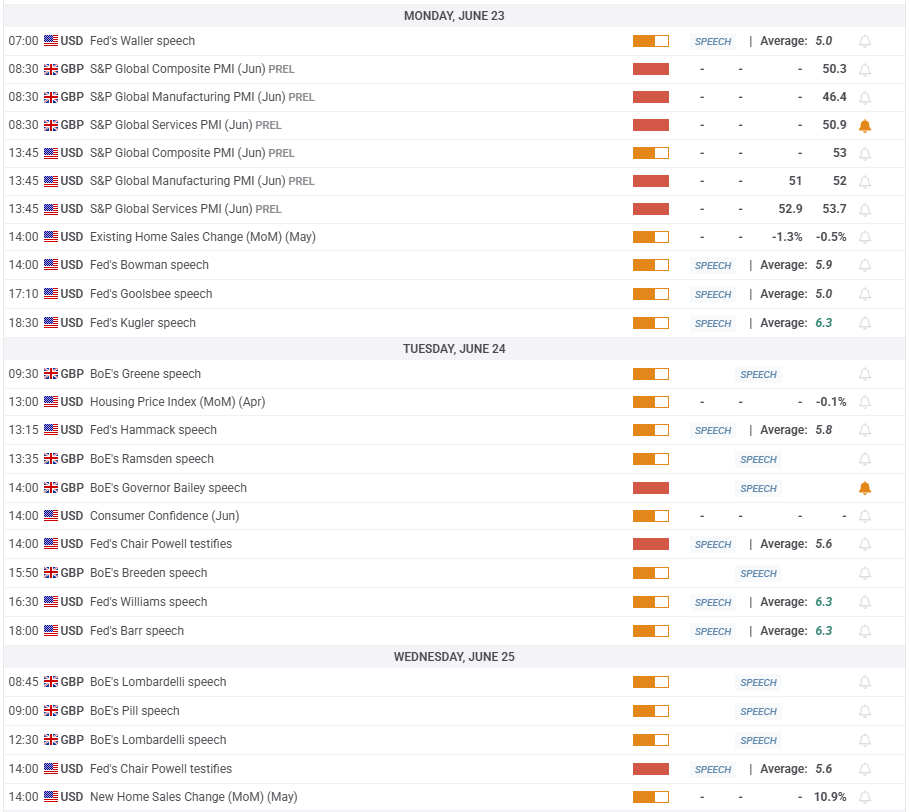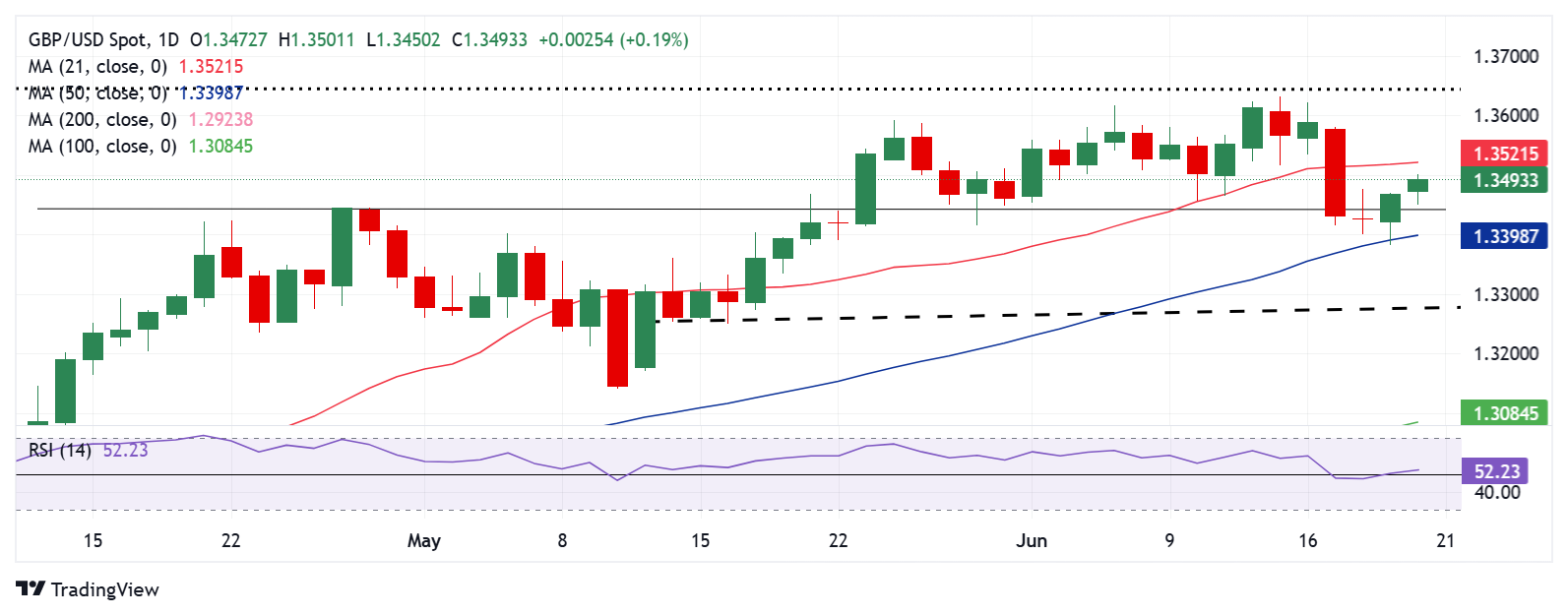
- The Pound Sterling rebounded slightly after hitting monthly lows against the US Dollar.
- GBP/USD looks to Powell’s and Bailey’s testimonies ahead of US PCE inflation data next week.
- Technically, the daily RSI flips bullish as the Pound Sterling defends 50-day SMA support.
The Pound Sterling (GBP) staged a late recovery against the US Dollar (USD) after the GBP/USD pair corrected sharply to monthly lows below 1.3400.
Pound Sterling buyers fight back control
The price action around the GBP/USD pair in the past week was mainly dictated by the ongoing developments surrounding the Israel-Iran geopolitical escalation even as trade uncertainties continued to linger.
The US Dollar received a double booster shot amid reviving safe-haven demand, courtesy of the Middle East conflict, and the hawkish hold decision by the US Federal Reserve (Fed).
This USD resurgence weighed heavily on the Pound Sterling, fuelling steep declines in the pair until mid-Thursday’s trading as markets digested the Bank of England’s (BoE) dovish policy outcome.
Last Sunday, Israel and Iran launched fresh attacks, raising concerns of a broader regional conflict that could hit trade flows under risks through the Strait of Hormuz.
Risk sentiment deteriorated and the Greenback gathered strength in the first half of the week, following speculations that the US could initiate an offensive operation against Iran, supporting its ally, Israel.
US President Donald Trump called for Iran’s unconditional surrender and held an emergency National Security Council (NSC) meeting earlier in the week.
Meanwhile, the US and Japan failed to reach a trade deal on the sidelines of the G7 Summit, curbing risk flows further as investors continued to run for cover in the US currency.
Midweek, the Fed announced that it held policy rates in the range of 4.25%-4.5%, as widely expected, while keeping the projections for two interest rate cuts this year intact.
However, it trimmed expectations for further cuts in 2026 and 2027. The Fed also slashed growth forecasts while revising the inflation outlook higher.
Markets quickly looked past the Fed verdict after several media outlets reported that the US was considering an attack on Iran as early as this weekend, with President Trump particularly weighing strikes on Iran’s heavily fortified Fordow nuclear facility.
However, the chatter quickly died down after Trump said late Thursday that he would delay his final decision on launching strikes for up to two weeks.
Early Friday, a US Senate Intelligence Committee Chair reported Trump as saying, “I will give Iran a last chance to make a deal before we strike.”
Ebbing Middle East fears diminished the USD’s safe-haven appeal, allowing GBP/USD to build on the rebound from four-week troughs of 1.3383.
Against this backdrop, the Pound Sterling stood resilient to the BoE’s dovish shift. The UK central bank kept interest rates steady at 4.25%, meeting the expectations. However, Governor Andrew Bailey hinted at cutting rates in the future.
The voting composition came out dovish. Six out of nine of the BoE’s Monetary Policy Committee (MPC) members opted to hold rates while three voted in favor of a 25 basis points (bps) cut. This compares with the 7-2 split that analysts had expected.
However, the recovery gains appeared capped amid a weak UK Retail Sales report and looming Middle East and trade uncertainty heading into the weekend.
The UK Retail Sales dropped by 2.7% in May, data from the Office for National Statistics (ONS) showed Friday, a much sharper decline than the 0.5% contraction expected. The core Retail Sales figure also fell short of market expectations.
Central banks’ talks and Middle East updates to dominate
Even though the Fed and the BoE policy announcements are out of the way, testimonies by Fed Chair Jerome Powell and his counterpart Andrew Bailey will be keenly awaited in the week ahead.
The week opens with a bang as the S&P Global preliminary Purchasing Managers’ Index (PMI) data from the US and the UK will be reported.
The business PMI data is critical to gauging the state of the economies on both sides of the Atlantic.
Bailey will testify before the Lords Economic Affairs Committee on Tuesday.
Powell’s testimony on the semi-annual Monetary Policy Report before the House Financial Services Committee also on Tuesday, followed by the hearings before the Senate on Wednesday.
Tuesday will also feature the US Conference Board (CB) Consumer Confidence data.
Moving on into the second half of the week, Governor Bailey is scheduled to speak at the British Chambers of Commerce, in London, on Thursday.
The focus will be also on the US Durable Goods Orders, Jobless Claims and final Gross Domestic Product (GDP) data on Thursday.
The week’s main highlight will drop on Friday – the Fed’s preferred inflation gauge, the core Personal Consumption Expenditures (PCE) Price Index, wrapping up another busy week.
Apart from the central bank speak and statistics, the developments on the trade front and geopolitical updates from the Middle conflict will continue to drive Pound Sterling markets during the week.


GBP/USD: Technical Outlook

Having faced rejection above the 1.3600 threshold on several occasions, GBP/USD finally caved into the bearish pressures and corrected sharply, breaching strong support levels on its way to challenging the critical 50-day Simple Moving Average (SMA) support at 1.3398.
Heading into the weekend, the bullish potential is back in play as the GBP/USD pair defended the mentioned demand zone.
The 14-day Relative Strength Index (RSI) has recaptured the midline, currently near 52, justifying the renewed upswing.
On its road to recovery, the pair scaled the powerful support-turned-resistance at 1.3445, the April 28 high.
The next topside barrier is the 21-day SMA at 1.3521. A sustained break above that level will open the door for a retest of 1.3600.
Further up, the monthly top of 1.3633 and the February 2022 high at 1.3643 will provide stiff resistance to buyers on the way to the 1.3700 round figure.
On the flip side, if the 21-day SMA acts as a tough nut to crack, Pound Sterling sellers will likely return to take on the 50-day SMA support of 1.3398 once again.
A sustained move below that level will trigger a fresh downtrend toward the 1.3260 static support.
The last line of defense for buyers is seen at the May 12 low of 1.3140.
BoE FAQs
The Bank of England (BoE) decides monetary policy for the United Kingdom. Its primary goal is to achieve ‘price stability’, or a steady inflation rate of 2%. Its tool for achieving this is via the adjustment of base lending rates. The BoE sets the rate at which it lends to commercial banks and banks lend to each other, determining the level of interest rates in the economy overall. This also impacts the value of the Pound Sterling (GBP).
When inflation is above the Bank of England’s target it responds by raising interest rates, making it more expensive for people and businesses to access credit. This is positive for the Pound Sterling because higher interest rates make the UK a more attractive place for global investors to park their money. When inflation falls below target, it is a sign economic growth is slowing, and the BoE will consider lowering interest rates to cheapen credit in the hope businesses will borrow to invest in growth-generating projects – a negative for the Pound Sterling.
In extreme situations, the Bank of England can enact a policy called Quantitative Easing (QE). QE is the process by which the BoE substantially increases the flow of credit in a stuck financial system. QE is a last resort policy when lowering interest rates will not achieve the necessary result. The process of QE involves the BoE printing money to buy assets – usually government or AAA-rated corporate bonds – from banks and other financial institutions. QE usually results in a weaker Pound Sterling.
Quantitative tightening (QT) is the reverse of QE, enacted when the economy is strengthening and inflation starts rising. Whilst in QE the Bank of England (BoE) purchases government and corporate bonds from financial institutions to encourage them to lend; in QT, the BoE stops buying more bonds, and stops reinvesting the principal maturing on the bonds it already holds. It is usually positive for the Pound Sterling.
Information on these pages contains forward-looking statements that involve risks and uncertainties. Markets and instruments profiled on this page are for informational purposes only and should not in any way come across as a recommendation to buy or sell in these assets. You should do your own thorough research before making any investment decisions. FXStreet does not in any way guarantee that this information is free from mistakes, errors, or material misstatements. It also does not guarantee that this information is of a timely nature. Investing in Open Markets involves a great deal of risk, including the loss of all or a portion of your investment, as well as emotional distress. All risks, losses and costs associated with investing, including total loss of principal, are your responsibility. The views and opinions expressed in this article are those of the authors and do not necessarily reflect the official policy or position of FXStreet nor its advertisers. The author will not be held responsible for information that is found at the end of links posted on this page.
If not otherwise explicitly mentioned in the body of the article, at the time of writing, the author has no position in any stock mentioned in this article and no business relationship with any company mentioned. The author has not received compensation for writing this article, other than from FXStreet.
FXStreet and the author do not provide personalized recommendations. The author makes no representations as to the accuracy, completeness, or suitability of this information. FXStreet and the author will not be liable for any errors, omissions or any losses, injuries or damages arising from this information and its display or use. Errors and omissions excepted.
The author and FXStreet are not registered investment advisors and nothing in this article is intended to be investment advice.







